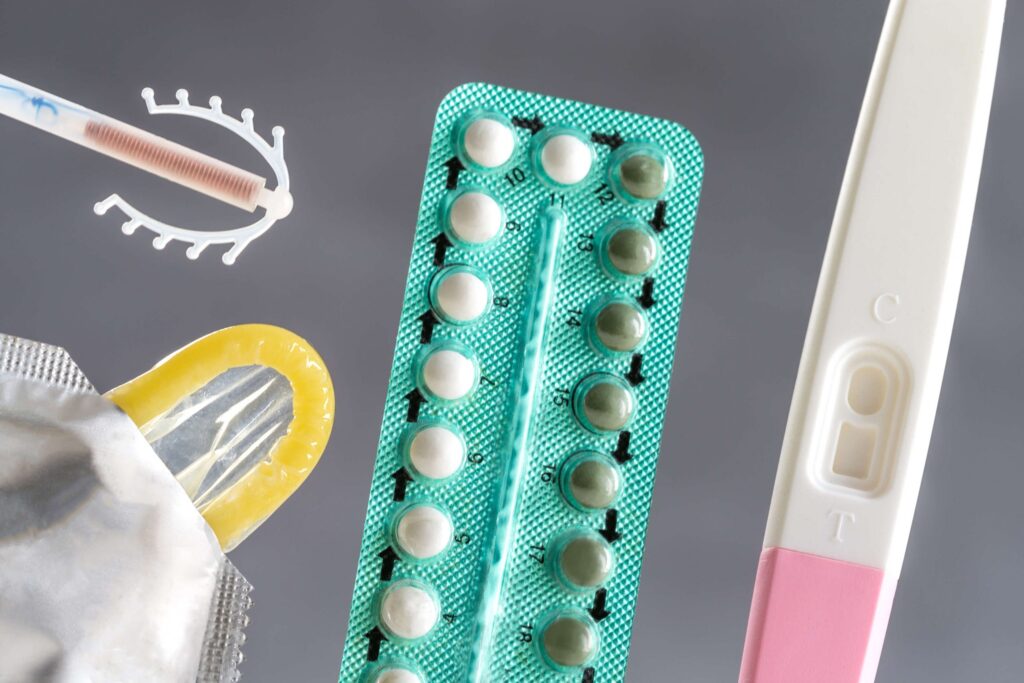Pregnancy contraception refers to the intentional prevention of pregnancy through various birth control methods. These methods work by inhibiting ovulation, fertilization, or implantation of a fertilized egg. Choosing the right form of contraception is a critical component of family planning and reproductive health.

Classification of Contraceptive Methods
Contraceptive options are broadly classified based on their mechanism, duration, and usage pattern.
1. Hormonal Contraception
Hormonal methods alter the body’s hormone levels to prevent ovulation.
Combined Oral Contraceptives (COCs)
- Contain estrogen and progestin
- Taken daily, highly effective when used consistently
- Also regulate menstrual cycles and reduce cramps
Progestin-Only Pills (Mini Pills)
- Suitable for women who cannot take estrogen
- Must be taken at the same time every day
Contraceptive Patch
- Worn on the skin; replaced weekly
- Delivers hormones transdermally
Vaginal Ring (e.g., NuvaRing)
- Placed inside the vagina for three weeks at a time
- Steady hormone release with low maintenance
Hormonal Injection (e.g., Depo-Provera)
- Administered every 12 weeks
- Highly effective but may cause delayed return to fertility
2. Long-Acting Reversible Contraceptives (LARC)
Ideal for women seeking long-term, low-maintenance birth control.
Intrauterine Devices (IUDs)
- Hormonal IUDs (e.g., Mirena, Skyla): release progestin, effective for 3–7 years
- Copper IUDs (e.g., ParaGard): hormone-free, effective for up to 10 years
Contraceptive Implant
- Inserted under the skin of the arm
- Releases progestin and is effective for up to 3 years
3. Barrier Methods
These physically block sperm from reaching the egg.
Male Condoms
- Made of latex, polyurethane, or lambskin
- Provide protection against sexually transmitted infections (STIs)
Female Condoms
- Inserted into the vagina before intercourse
- Offer dual protection against pregnancy and STIs
Diaphragm and Cervical Cap
- Must be used with spermicide
- Require proper fitting and placement
4. Permanent Contraception
For individuals who no longer wish to conceive.
Tubal Ligation (Female Sterilization)
- Involves blocking or sealing fallopian tubes
- Permanent and over 99% effective
Vasectomy (Male Sterilization)
- Seals or cuts the vas deferens
- Simple outpatient procedure with high success rate
5. Emergency Contraception
Used after unprotected sex or contraceptive failure.
Emergency Contraceptive Pills (ECPs)
- Most effective when taken within 72 hours
- Common types: Levonorgestrel (Plan B), Ulipristal Acetate (Ella)
Copper IUD as Emergency Contraception
- Can be inserted within 5 days after unprotected sex
- Most effective emergency contraceptive available
Effectiveness Comparison of Contraceptive Methods
| Method | Typical Use Effectiveness | Notes |
|---|---|---|
| Implant | >99% | Long-term, low maintenance |
| Hormonal IUD | >99% | May reduce menstrual bleeding |
| Copper IUD | >99% | Hormone-free, long-term |
| Birth Control Pills | 91% | Daily adherence required |
| Contraceptive Patch | 91% | Weekly replacement |
| Depo-Provera Injection | 94% | Requires clinic visit every 3 months |
| Male Condom | 85% | Also prevents STIs |
| Female Condom | 79% | Can be inserted hours before sex |
| Diaphragm with Spermicide | 88% | Must remain in place after sex |
| Tubal Ligation | >99% | Permanent |
| Vasectomy | >99% | Permanent |
| Emergency Pills | 58–85% | Sooner taken = higher efficacy |
| Copper IUD (Emergency Use) | >99% | Within 5 days post-intercourse |
Choosing the Right Contraceptive Method
Several factors should be considered:
- Health profile: Age, medical conditions, menstrual history
- Lifestyle: Frequency of intercourse, ability to adhere to a routine
- Future fertility goals: Desire for children later
- Protection against STIs: Use barrier methods when STI risk exists
- Cost and accessibility: Some methods may require insurance or prescriptions
A consultation with a healthcare provider ensures the chosen method aligns with both medical needs and personal preferences.
Common Myths About Contraception
- Myth: Birth control causes infertility.
Fact: Most methods allow full return to fertility upon discontinuation. - Myth: Hormonal contraception is unsafe long-term.
Fact: Long-term use is generally safe for healthy individuals. - Myth: You can’t get pregnant while breastfeeding.
Fact: Lactational amenorrhea may reduce fertility but is not foolproof. - Myth: Condoms always prevent pregnancy.
Fact: Condoms are effective but have a higher failure rate compared to LARCs.
Contraception and Special Populations
Adolescents
- Education and access are essential to prevent unplanned teenage pregnancies
- Long-acting methods like implants and IUDs are safe and effective for teens
Postpartum Women
- Fertility can return as early as 6 weeks postpartum
- Progestin-only pills or IUDs are preferred for breastfeeding mothers
Perimenopausal Women
- Pregnancy is still possible until menopause is confirmed
- Hormonal methods can also help manage menopausal symptoms
FAQs:
Which contraceptive method is the most effective?
Long-acting reversible contraceptives (IUDs and implants) and sterilization offer the highest efficacy.
Is it safe to use contraception immediately after childbirth?
Yes, some methods like IUDs and progestin-only pills are safe and recommended postpartum.
Can contraception affect future fertility?
Most methods are reversible and do not impact long-term fertility.
Are there non-hormonal options available?
Yes, copper IUDs, condoms, diaphragms, and fertility awareness methods do not involve hormones.
How soon after stopping contraception can I get pregnant?
Fertility may return immediately or within a few months, depending on the method used.
Selecting a pregnancy contraception method is a personalized decision requiring consideration of health, lifestyle, and reproductive goals. With an array of modern contraceptive options—ranging from short-term to long-acting and reversible to permanent—every individual can find a method that aligns with their needs. Empowering individuals through education and access to care is essential for effective family planning and reproductive autonomy.